Introduction
Rock sugar stewed pear, a beloved traditional Chinese dessert, combines the natural sweetness of pears with the delicate caramel-like flavor of rock sugar. This soothing dish is not only a treat for the taste buds but also a remedy rooted in Chinese culinary and medicinal traditions. Often served warm or chilled, it is praised for its ability to moisturize the throat, alleviate coughs, and provide comfort during colder months. Despite its simplicity, achieving the perfect balance of flavors and textures requires attention to detail. This article will guide you through the process of crafting this timeless dessert, from selecting the finest ingredients to mastering the stewing technique. Whether you are a novice cook or a seasoned chef, this guide will equip you with the knowledge to create a bowl of rock sugar stewed pear that honors tradition while delighting modern palates.
Understanding the Ingredients
-
Pears: The Foundation of Flavor
The star ingredient, pears, plays a pivotal role in this recipe. In China, Asian pears (also known as nashi pears) are traditionally favored for their crisp texture and floral aroma. These pears have a round shape, golden-brown skin, and a grainy texture that softens beautifully when stewed. However, if Asian pears are unavailable, Bosc or Anjou pears make excellent alternatives. When selecting pears, choose firm, unblemished fruits with smooth skin. Avoid overripe pears, as they may become mushy during cooking. -
Rock Sugar: The Sweetener of Choice
Rock sugar, or bing tang in Chinese, is a crystalline sweetener made from sugarcane or beet juice. Unlike refined white sugar, rock sugar dissolves slowly, imparting a subtle, mellow sweetness without overpowering the pears’ natural flavor. It is available in irregularly shaped crystals or blocks and can be found in Asian grocery stores or online. If unavailable, raw cane sugar or coconut sugar may be used as substitutes, though the flavor profile will differ slightly. -
Complementary Ingredients
While the classic recipe requires only pears and rock sugar, many cooks enhance the dish with complementary ingredients: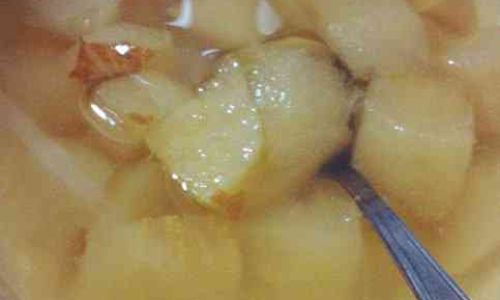
- Goji Berries (Wolfberries): These vibrant red berries add a tart-sweet flavor and a chewy texture. They are also rich in antioxidants.
- Dried Lily Bulbs: These delicate, slightly bitter bulbs contribute a floral note and are believed to have calming properties.
- Jujube (Red Dates): Sweet and chewy, jujubes lend a caramel-like depth to the broth.
- Fresh Ginger: A thin slice of ginger introduces a subtle warmth, balancing the sweetness.
Preparation: Crafting the Perfect Base
-
Preparing the Pears
- Peeling: Use a vegetable peeler to remove the skin carefully, ensuring minimal waste. Some recipes retain the skin for added fiber, but peeling ensures a smoother texture.
- Coring: Cut the pear in half vertically. Using a melon baller or a small spoon, scoop out the core, including the seeds and fibrous center. Leave the stem intact for an elegant presentation.
- Shaping (Optional): For a decorative touch, trim the base of each pear half to create a flat surface, allowing it to stand upright in the pot.
-
Soaking Dried Ingredients (If Using)
If incorporating goji berries or lily bulbs, soak them in warm water for 10–15 minutes to rehydrate. This step softens their texture and reduces cooking time.
The Stewing Process: Patience and Precision
-
Selecting the Right Pot
A heavy-bottomed ceramic or stainless-steel pot is ideal for even heat distribution. Avoid aluminum pots, as they may react with the ingredients and impart a metallic taste. -
Layering Ingredients
- Place the prepared pears at the bottom of the pot, cut-side down.
- Add the rock sugar around and on top of the pears. For a balanced sweetness, use 2–3 tablespoons of rock sugar per medium pear, adjusting to taste.
- Toss in any complementary ingredients (goji berries, jujubes, etc.).
-
Adding Liquid
Pour enough water into the pot to submerge the pears halfway—approximately 4–5 cups for four pears. The water should not completely cover the fruit to prevent over-dilution of flavors.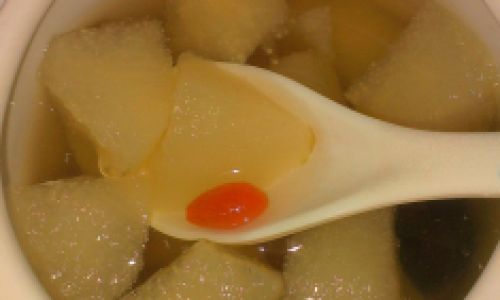
-
Simmering to Perfection
- Bring the mixture to a gentle simmer over medium heat. Once bubbles appear, reduce the heat to low.
- Cover the pot with a lid slightly ajar to allow steam to escape, preventing the pears from becoming too soft.
- Simmer for 30–40 minutes, or until the pears are tender but not falling apart. Check periodically by piercing the flesh with a fork—it should meet minimal resistance.
-
Enhancing the Broth
- For a richer flavor, add a strip of orange zest or a cinnamon stick during the last 10 minutes of cooking.
- If the broth is too sweet, balance it with a squeeze of fresh lemon juice.
Serving Suggestions: Elevating the Experience
-
Temperature Variations
- Warm: Serve immediately in shallow bowls, garnished with a sprinkle of goji berries or a mint leaf.
- Chilled: Refrigerate the stewed pears for 2–3 hours for a refreshing dessert. The flavors will meld further as it cools.
-
Accompaniments
- Drizzle a teaspoon of honey or osmanthus syrup over the pears for added complexity.
- Pair with a scoop of vanilla ice cream or a dollop of Greek yogurt for a contrast of temperatures and textures.
-
Presentation Tips
- Place the pear half in the center of the bowl and ladle the broth around it.
- Garnish with edible flowers, such as chrysanthemums, for a touch of elegance.
Health Benefits: More Than Just a Dessert
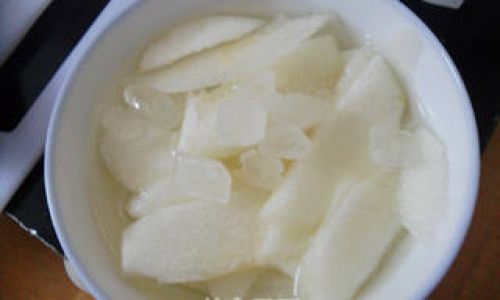
Rock sugar stewed pear is celebrated not only for its taste but also for its nutritional and medicinal properties:
-
Throat Soothing
The combination of pears and rock sugar creates a mucilaginous broth that coats the throat, providing relief from dryness or irritation. This makes it a popular remedy for coughs, especially in children. -
Hydration and Nutrition
Pears are rich in dietary fiber, vitamin C, and potassium, promoting digestion and immune health. The slow-cooking process preserves these nutrients while making the fruit easier to digest. -
Antioxidant Boost
Goji berries and jujubes add a dose of antioxidants, which combat oxidative stress and support overall well-being. -
Low-Calorie Indulgence
Unlike many desserts, this dish is relatively low in calories, making it a guilt-free treat for health-conscious individuals.
Troubleshooting Common Issues
-
Pears Turning Mushy
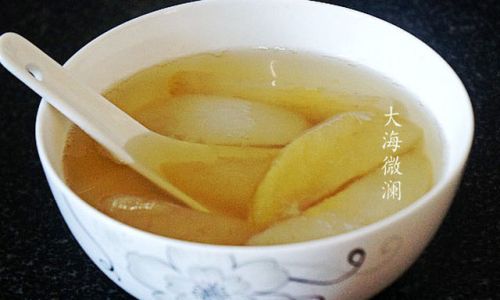
- Cause: Overcooking or using overly ripe pears.
- Solution: Reduce cooking time by 5–10 minutes and select firmer pears next time.
-
Broth Too Sweet
- Cause: Excessive rock sugar.
- Solution: Dilute with water or add a squeeze of lemon juice to balance the sweetness.
-
Broth Not Thickening
- Cause: Insufficient simmering time or high heat.
- Solution: Remove the lid and simmer uncovered for an additional 10–15 minutes to reduce the liquid.
-
Pears Floating Unevenly
- Cause: Uneven distribution of ingredients.
- Solution: Arrange the pears carefully and ensure they are partially submerged in liquid.
Cultural Significance: A Bowl of Tradition
In Chinese culture, rock sugar stewed pear is more than a dessert—it is a symbol of care and nurturing. Often prepared by mothers for their children, it is served during festivals, family gatherings, and as a gesture of hospitality. During the Lunar New Year, it is believed to bring good health and prosperity. The act of stewing the pears slowly over low heat mirrors the patience and attention required to nurture relationships, making this dish a metaphor for love and tradition.
Variations and Modern Twists
While the classic recipe is timeless, contemporary cooks often experiment with innovative additions:
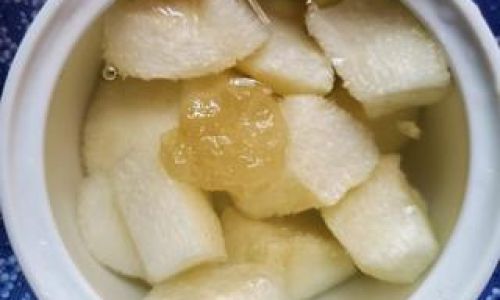
-
Herbal Infusions
Add dried chrysanthemum flowers or honeysuckle for a floral aroma and additional health benefits. -
Spiced Variations
Incorporate a star anise pod or a vanilla bean during cooking for a warm, aromatic twist. -
Vegan-Friendly Options
Substitute rock sugar with maple syrup or coconut nectar for a plant-based alternative. -
Alcoholic Pairings
For adults, a splash of brandy or Chinese rice wine (like Shaoxing) added just before serving imparts a sophisticated depth.
Conclusion: A Labor of Love
Rock sugar stewed pear is a testament to the beauty of simplicity. With its humble ingredients and meticulous preparation, it embodies the essence of Chinese home cooking—nourishing, comforting, and steeped in tradition. Whether you seek relief from a dry throat, a connection to cultural heritage, or simply a delightful dessert, this recipe offers a rewarding culinary journey. So, gather your pears, measure your rock sugar, and embark on a steaming adventure that transcends time and taste. Your effort will be rewarded with a bowl of golden sweetness, a testament to the art of slow cooking and the joy of sharing a timeless treasure.

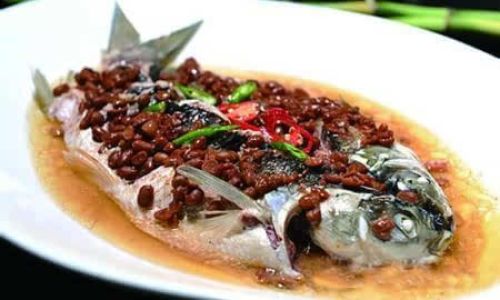
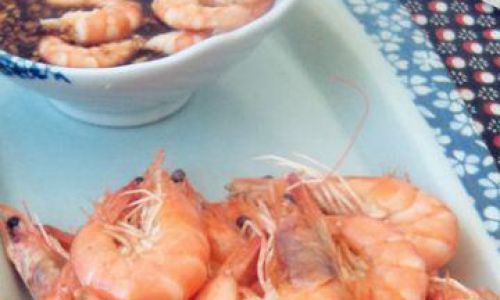
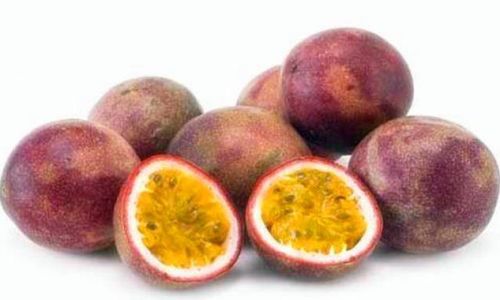

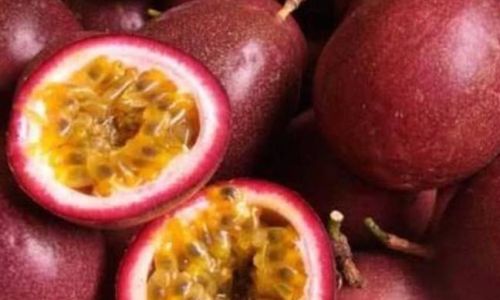
0 comments